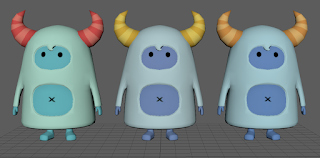1. What went right / worked well or better than expected?
- Finishing all Tasks before deadlines. We had a committed group who wanted to ensure we all pull our weight and each member managed to finish their assigned tasks just in time. We had a good level of communication on Facebook.
-Models/Textures. I believe we surprised ourselves at how well some of our assets came out, particularly after Zoe refined my models. The rendered screenshots by Alex with the textures by Georgia (and Zoe) look marvellous. In the end, we had a decent collection of finished and textured models.
-Team Co-operation. The team worked pleasantly together and any disagreements were able to be resolved in a civil and respectable manner. Group meeting attendance was good.
-First Playtests. Despite many issues with Unity and our difficulty with our Pig mechanics, we were pleasantly surprised how quickly and smooth our first playable build which Alex put together worked.
2. What went wrong / didn’t really work?
-Last Minute Rushes. Our team had a bad habit of being finished at the last minute. While not necessarily because we started too late, perhaps we spent too long experimenting and fiddling around on certain things such as which style of camera angle we wanted.
-Differences in art styles. While we agreed with how the game should look, we still had very different art styles that were a challenge to put together, but having a 2D art lead (Georgia) greatly helped in the consistency.
-Inexperience in Maya and Problems with Git and Unity. I believe our team members should have been a bit more prepared in having up-to-date software at home, learning Maya skills such as exporting or asking for help sooner. Because of our experience, we had to leave almost anything Unity related to Alex.
-Picking a style of game that was challenging. We may have found it much easier with a more simpler style such as a platformer, however, our final version Yoink certainly challenged us and pushed us to learn new skills.
-Animations. While I wanted to challenge myself and practice learning on my own, I should have asked for help sooner which would have saved time. Earlier communication between the animator (me) and the programmer (Alex) in what was required for the animations to be unity-ready would have helped both of us. From watching youtube videos from games conferences, it seems like this is a common problem in the industry.
3. What would you do differently next time?
- Broaden our skill-sets so we would be able to work more closely with the same software together.
- Ask for help sooner
- Learn even more about Unity.
- More environment models and details.
- Extensive back-ups for when models break (such as the lizard) and Unity scenes. Having Git as the only source for backups is not recommended.
- Start Animations much sooner. Perhaps instead of doing all the models and then the animations, doing one by one would have been better.
- Plan more time for the finishing touches. We focussed so much on just getting everything complete in time that we forgot to budget enough time for polish. If we'd had the time to polish, we could have fixed all those little things that make a game look professional and complete, like lighting and particle effects.
- Plan more time for the finishing touches. We focussed so much on just getting everything complete in time that we forgot to budget enough time for polish. If we'd had the time to polish, we could have fixed all those little things that make a game look professional and complete, like lighting and particle effects.








